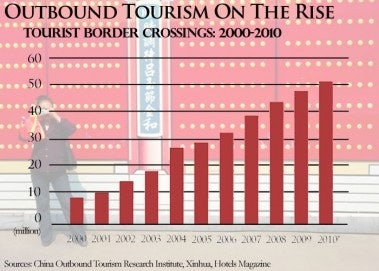Follows Trend Of Increased Chinese-Language Signage At Tourist Sites, Mandarin-Language Tours#

It's been a difficult couple of years for the global tourism industry, which saw an aggregate drop in international tourist arrivals of around 4-6% in 2009. However, there are signs that the industry's woes, which were exacerbated last year by the global financial crisis and the H1N1 virus, may be on the verge of turning around, powered by an increase in outbound tourists from emerging markets like China.
Jing Daily has extensively covered the ever-growing ranks of Chinese tourists heading abroad, many of them doing so for the first time. Much like the still-sluggish luxury industry, the booming China outbound tourism market is helping to counter the drop in outbound tourists from longtime industry powerhouses like the US and Japan. As we wrote a couple of months ago, in 2009 Chinese outbound tourists spent some $42 billion overseas, a significant number, but one that is even more intriguing for tour operators around the world because this $42 billion was spent by only around 40 million tourists (a number that should surpass 50 million this year), indicating that Chinese tourists are -- as we and many other have pointed out -- developing a reputation among retailers and tourism professionals as being big spenders.
To court the growing number of Chinese outbound tourists, Western tour operators, hoteliers and retailers are finding that it's becoming more important to understand the particular needs of these tourists. This week, at the China Outbound Tourism Marketing Seminar at ITB Berlin, the world's largest tourism fair, one of the key topics was how to most effectively implement outreach efforts and marketing to potential Chinese tourists. Among the trends discussed by attendants as an increasingly influential for Chinese tourists when planning trips abroad was social media. From Hotels Magazine:
China is the country with the largest number of internet users in the world and has also developed into the largest tourism source market in Asia. With growing choice and sophistication of the Chinese travellers, destinations and companies have to use up-to-date communication to reach the attention and imagination of these high-spending customers. Facebook, Twitter and Youtube are banned in China, but their Chinese equivalents are getting even more traffic than the "western" services.
...
Social Media are increasingly important especially for the younger, affluent and techno-savvy Chinese. Word of Mouth and Word of Mouse are key elements of reaching this crucial segment of the Chinese outbound market. It is also an excellent barometer of the rapidly evolving consumer trends and interests that are relevant for destinations seeking to attract a greater share of this market, as Jens Thraenhart Executive Partner of Beijing-based Dragon Trail illustrated in his presentation.
With indications that the Chinese government is hoping to encourage outbound tourism growth rates of around 9% per year, attendants at the seminar agreed that it's becoming more important than ever to learn more about what Chinese tourists most hope for in overseas tourism and aggressively cater to these preferences.
Much like the increase in Japanese signage and other gestures that hotels and many tourist sites implemented in the 1980s when Japanese tourists began to venture outward in record numbers, we can expect to see more of these changes taking place to cater to the millions of mainland Chinese who are doing the same.